A. Sutherland – AncientPages.com – Vikings used several ancient symbols based on Norse mythology. Symbols played a vital role in Viking society and were used to represent their gods, beliefs, and myths. Some Viking symbols remain mysterious, and their meaning is still unknown, but many ancient symbols have clear messages.
In this top list, we examine some of the most powerful and significant Viking symbols and explore their meaning.
1. Thor’s Hammer – Mjölnir
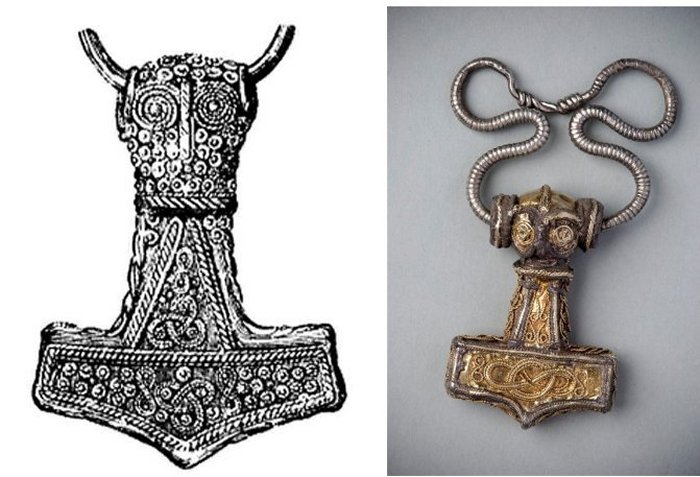
Left: Drawing of a Viking Age gold-plated silver Mjölnir pendant (length 4.6 cm) found at Bredsätra in Öland, Sweden, now kept in the Swedish Museum of National Antiquities. Right: A 10th century Thor’s Hammer (Mjölnir) from Odeshog, Sweden
Mjölnir means lightning, and Thor’s hammer indicates God’s power over thunder and lightning. Thor, the ancient God of war, is one of the most prominent figures in Norse mythology. Thor, the storm-weather God of sky and thunder and a fertility god, was the son of Odin and Fyorgyn, the earth goddess.
Thor’s hammer, Mjölnir, is depicted in Norse mythology as one of the most fearsome weapons, capable of leveling mountains. One Norse story tells what happened when he lost his precious hammer.
Mjölnir was a magical weapon that always returned to Thor when he threw it. Wearing Thor’s hammer as an amulet of protection was quite common as this was probably the most popular pagan Viking symbol. Even during Christian times, from A.D. 1000 on, Vikings wore Thor’s Mjölnir and a cross on a chain or thong around their necks.
2. Yggdrasil – Norse Tree Of Life
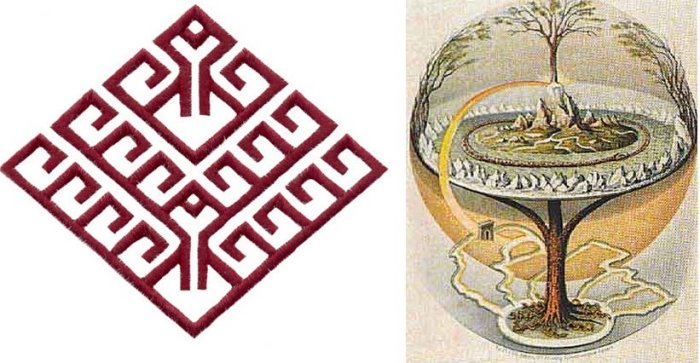
Left: Yggdrasil symbol; Right: An 1847 depiction of the Norse Yggdrasil as described in the Icelandic Prose Edda. By Oluf Olufsen Bagge
In Norse mythology, the Yggdrasil is a giant mythological tree that holds together the Nine Worlds or realms of existence.
At the very top of Yggdrasil, an eagle lived, and at the bottom of the tree lived a dragon named Nidhug. Both hated each other and were bitter enemies. The Nine Worlds are guarded by the serpent Jormungandr. Yggdrasil is one of many variations of the Cosmic Axis or Universal World Tree known to all human cultures and home to many fascinating creatures.
The image of Yggdrasil appears on the famous Överhogdal Tapestry, which dates to the year 1066 and depicts the events of Ragnarok, the doom of the Gods, and the apocalyptic record of the coming comet.
3. Valknut – Viking Symbol For Death In A Battle
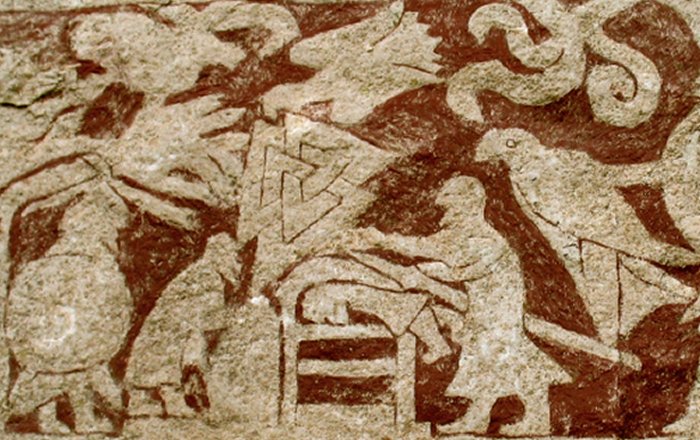
Stone fragment from Stora Hammar I, Gotland. A valknut stands prominently in the center, next to a character analyzed as the god Odin, with his characteristic spear . He pushes another figure into a burial mound, while a crow hangs above his head and another man is hanged. Image uploader: The Man in Question – CC BY-SA 3.0
The Valknut is a mysterious Norse symbol, also known as Hrungnir’s heart, the heart of the slain, the Heart of Vala, and Borromean triangles. Its true meaning is still debated but often ᴀssociated with a warrior’s death in a battle.
The symbol has been found on old Norse stone carvings and funerary steles. It is sometimes called “Hrungnir’s heart,” after the legendary giant of the Eddas. It’s also possible to find a depiction of the Valknut on stone carvings as a funerary motif, which probably signified the afterlife. The Valknut represents God Odin in art, demonstrating the gods’ power over death. A Valknut is also believed to offer protection against spirits, so it is often carried as a talisman.
A Valknut is made of three parts, and the number three is a prevalent magic symbol in many cultures. In this case, the symbolism in Norse mythology showing three multiplied by three might designate the nine worlds united by the Yggdrasil tree. In modern times Valknut, like Triquetra and Horn Triskelion, is often interpreted as a symbol pointing to heathen convictions.
4. The Helm Of Awe – Viking Symbol For Protection
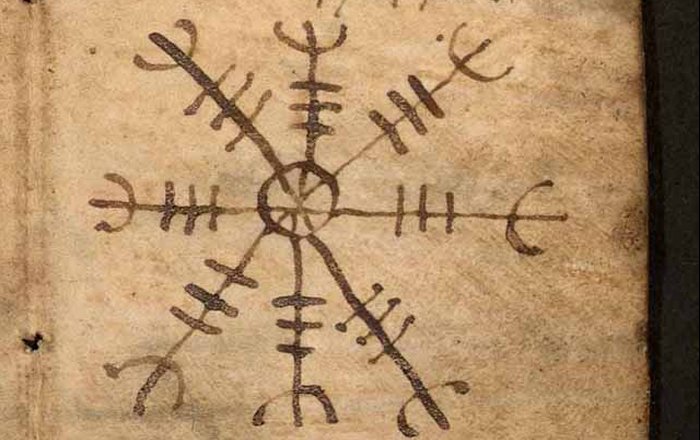
Ancient engraving of Helm of Ægir . It shall be made in lead, and when a man expects his enemies from him he shall imprint it on his forehead from him. And you will conquer him. Public domain
The Helm of Awe is one of the most powerful protective Viking symbols used not only for protection from disease but even to encourage all people who might suffer from depression or anxiety.
In Norse myths, the Helm of Awe symbol was worn between the eyes to cause fear in your enemies and protect against the abuse of power. The Norse word for this significant symbol (Ægishjálmr or Aegishjalmur) is translated in English as “helm of awe” or “helm of terror.” The meaning of the name awe is to strike with fear and reverence; to influence by fear, terror, or respect; as his majesty awed them into silence.
5. Huginn And Muninn – The Twin Ravens In Norse Mythology
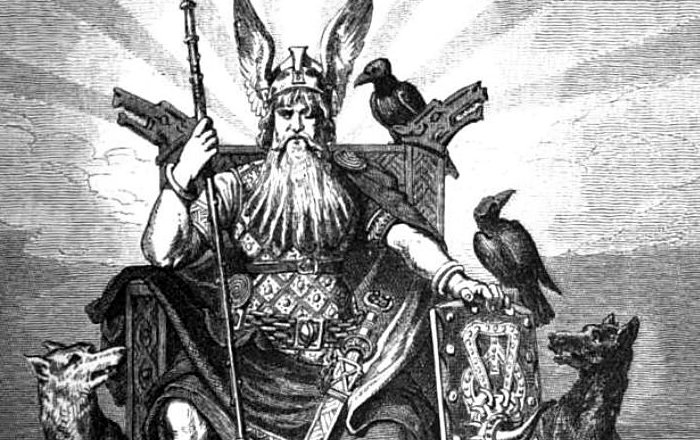
Odin enthroned and holding his spear Gungnir, flanked by his ravens Huginn and Muninn and wolves Geri and Freki (1882) by Carl Emil Doepler
Among the Aesir gods in Norse mythology, the supreme God, Odin, is frequently depicted sitting on his high seat, Hlidskjalf, in Asgard, the home of the gods.
Odin always has his two raven companions, Hugin (Huginn) and Munin (Munnin), on his shoulders.
Hugin is believed to represent ‘memory,’ while Munin personifies ‘thought.’ Odin sends them out daily, and they fly worldwide to seek important news and events. Odin surveys the worlds from Hlidskjalf and must-know reports of what is happening in all Nine Worlds. In the evening, Hugin and Munin return to Odin’s shoulders, and during dinner in Valhalla, they whisper all they have heard in his ears.
6. Web Of Wyrd (Skuld’s Net) – Viking Matrix Of Fate
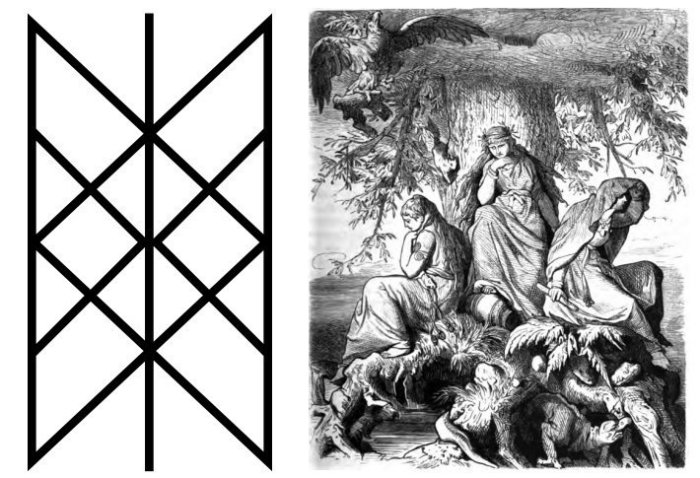
Left: Web Of Wyrd (Skuld’s Net); Right: The Norns – Urðr, Verðandi, and Skuld under the world oak Yggdrasil. Illustration, 1882 by Ludwig Burger via Wikipedia
In Norse mythology, the concept of fate is reflected by the Web of Wyrd that is created by the Norns, who were known as ‘Shapers of Destiny. The Norns were goddesses who ruled the fates of people, determining individuals’ destinies and lifespans.
With its nine staves, the Web of Wyrd is a matrix of fate that represents past, present, and future events in a person’s life. Norse people believed that everything we do in life affects future events and thus, all timelines, the past, present, and future, are connected with each other.
7. Troll Cross – Norse Symbol Protecting Against Trolls And Elves
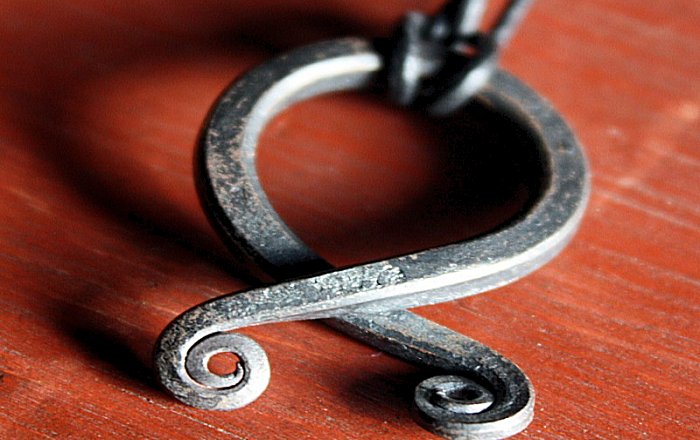
A troll cross amulet. Image credit: – CC BY 3.0
The troll cross is an amulet made of a circle of iron crossed at the bottom in the shape of an odal rune. Scandinavian people wore it as a protection against trolls and elves. It protected humans, animals, and possessions. It was made of a wrought iron piece and could have a few different forms, but essentially, its two ends must cross each other. The symbol allegedly originated in medieval Sweden.
8. The Triple Horn Of Odin
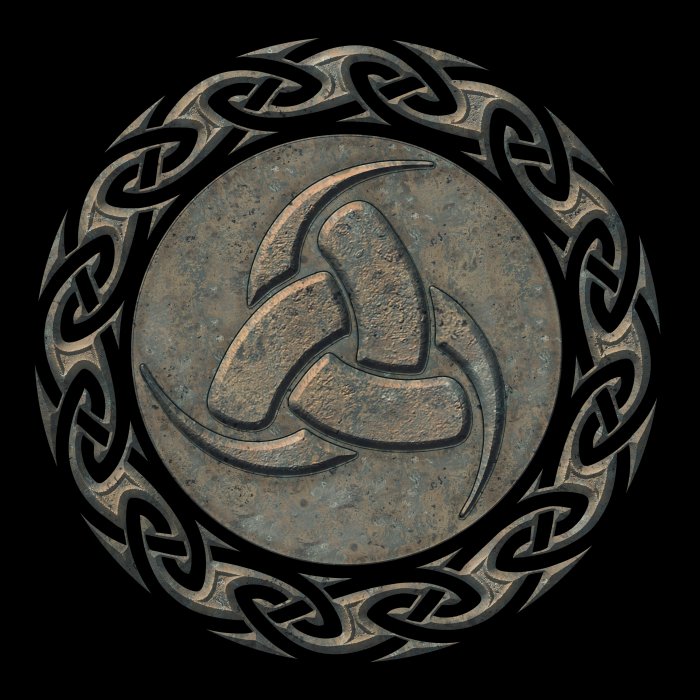
Credit: Adobe Stock – Anne Mathiasz
The Triple Horn of Odin is yet another symbol of the great Norse God Odin. It consists of three interlocked drinking horns and is commonly worn or displayed as a sign of commitment to the modern Asatru faith. The horns figure in the mythological stories of Odin and are recalled in traditional Norse toasting rituals. In Norse mythology, some tales describe God’s quest for the Odhroerir, a magical mead brewed from the blood of the wise God Kvasir. There are several accounts of the story, but typically, Odin uses his wits and magic to procure the brew over three days; the three horns reflect the three draughts of the magical mead.
9. Gungnir – The Spear Of Odin
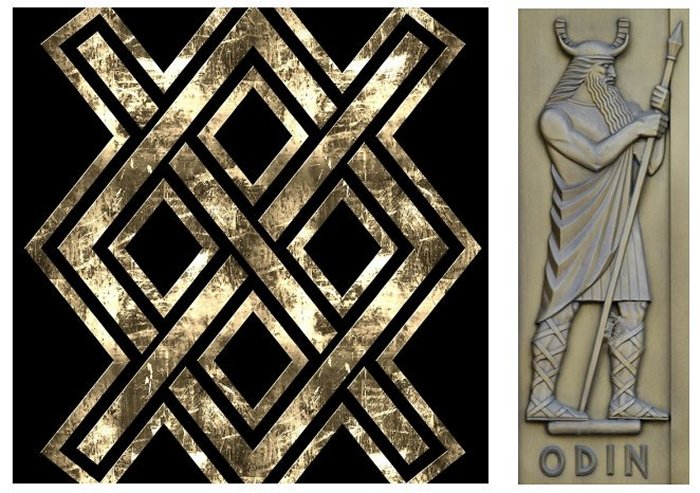
Left: Gungnir – Viking symbol; Right: Odin (1939). Library of Congress John Adams Building, Washington, D.C.
One of many colorful epithets of the great god Odin was “Lord of the Spear.” He owned Gungnir (in Old Norse means “swaying one”), a magical weapon that was unstoppable in its fight and governed the fortunes of war. Gungnir was a formidable weapon created by the dwarves and given to Odin by Loki. The Gungnir never missed its mark; like Mjölnir, Thor’s hammer, it always returned to Odin.
In ‘Sigrdrivomal,’ a part of the Poetic Edda text in Codex Regius, a sailor mentions that Odin carved runes on Gungnir’s cape, and they held magical powers. Sometimes Odin entrusted to Hermod’s care the precious spear Gungnir, bidding him to cast it over the combatants’ heads about to engage in battle.
As the god of war, Odin usually carried the infallible Gungnir spear in his hand, and this fantastic weapon was so sacred that an oath sworn upon its point could never be broken.
10. Vegvisir – Runic Compᴀss
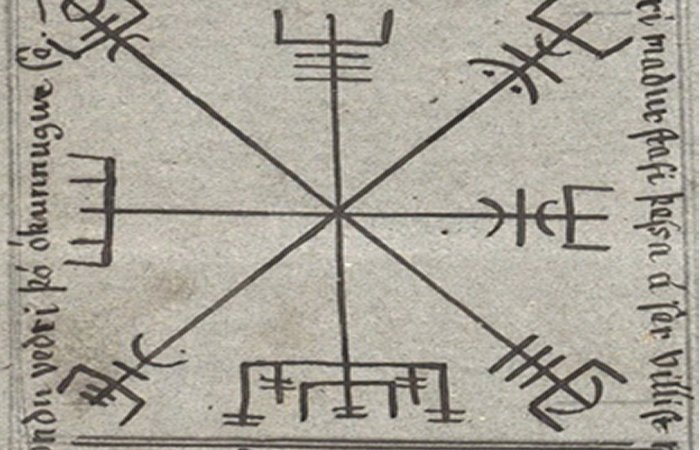
Portion of page 60 of Huld Manuscript ca. 1860 showing two Vegvisir symbols with тιтle and description of use in Icelandic. Image credit: Geir Vigfússon – Public Domain
Vegvisir is among the oldest and sacred Norse symbols, and it initially originated in Iceland, where ‘Vegur’ means – road or path and ‘Vísir’ means – Guide. It was frequently inscribed on seagoing vessels to ensure their safe return home.
The device was believed to show the way back home and protect seamen and their ships from storms. The Vegvisir was like a guide helping its bearer to find his way home. Norse people believed the Vegvisir had special powers and treated it as a talisman for luck, protection, and blessings. This powerful symbol could help a person to find the right way in storms or bad weather, whatever unfamiliar surroundings they may encounter.
It has also long played an important role among people who believe in magic powers, such as Norse Shamans. As a spiritual compᴀss, this magical device guides your heart and steps to make the right choices in life. If you have lost yourself and your faith, this sacred symbol helps you find confidence again.
Written by – A. Sutherland – AncientPages.com Senior Staff Writer
Copyright © AncientPages.com All rights reserved. This material may not be published, broadcast, rewritten or redistributed in whole or part without the express written permission of AncientPages.com
Expand for references
References:
Kirsten Wolf – Viking Age: Everyday Life During the Extraordinary Era of the Norsemen
Britannica- Yggdrasil
Viking Mythology – Yggdrasil
Viking Rune – Valknut
Gnostic Warrior – Helm Of Awe
Symbol Dictionary – Web Of Wyrd
MessageToEagle.com – The Norns – Shapers Of Destiny Who Recorded Days In Person’s Life In Norse Mythology
Justin Pollard – The World of Vikings





